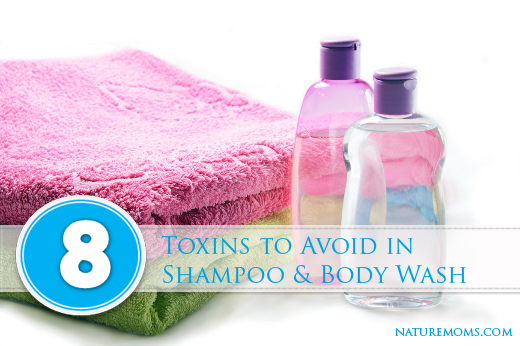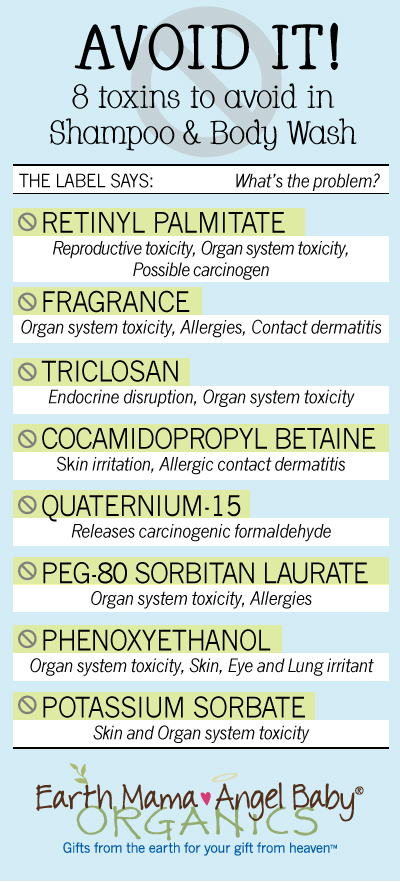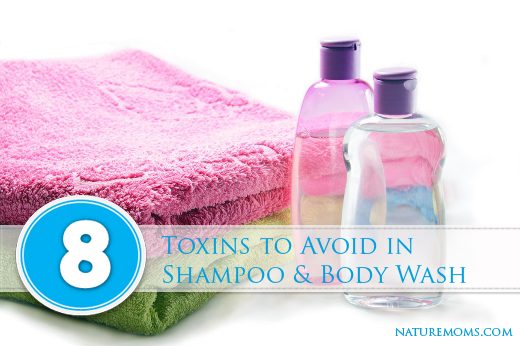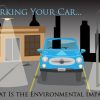
The ingredients in shampoos, soaps, and other body washing products are something that I never gave much thought to until I had children. Okay, okay…you got me. Truth be told I didn’t even give it much thought after my first child was born. I was one of those naive consumers who thought that the government would never allow products with unsafe ingredients to be sold to the public. I thought that if a product was on a store shelf then it MUST be approved by Uncle Sam and it MUST be safe for me (and my children) to use. Why on earth would my government allow corporations to sell me toxic products right? It just wouldn’t happen!!
Yeah, that is what I used to think and that is what many millions of people in this country think right now. Sadly, it is not based in reality. The truth is that corporations get away with far too much and they are allowed to use the research and data they pay for to show that their products are safe. The fox is guarding the hen house. Also no one looks at the cumulative exposure of all ingredients we come into contact with. For instance when a company uses a known carcinogen in their product they hide behind the fact that their own scientists have deemed it safe in the small quantities that they use. Yet they do not tell you that they also use this ingredient in their body wash, lotion, and deodorant. That small dose isn’t so small when you consider just how many products the average person uses.
Remember the first Batman movie with Michael Keaton in it? I like to use that movie to illustrate the point. When the Joker was poisoning the population no one could figure out how. It was Batman who figured out that he had poisoned various chemical components of beauty products and that their combination would trigger some rather nasty side effects. Use the hair spray alone and you would be fine but combine that hair spray with lipstick and deodorant and you just poisoned yourself. That was a movie but reality isn’t so far off the mark.
I was awakened to the dangers of blind consumerism when my first child became very sick and I found myself pregnant again. I was bound and determined to parent “smarter” and make better choices. To this day (that was many years ago) I haven’t let up on my demand for safe and non toxic products and I still insist upon boycotting the companies who don’t seem to have a conscience when it comes to our health and safety. My children are older now and typically use the same products I do for washing…simple bar soap. Though I do have one child who insists upon a liquid body wash and back when they were little we used organic baby shampoo. It is worth the time and effort to source out the safer products.
Below are some common shampoo ingredients and the health problems they have been associated with:

You don’t have to take anyone’s word for it though. Check the Skin Deep Database from the Environmental Working Group and look up these ingredients or the ones on your current bottle of shampoo and body wash. When you learn that products sitting on store shelves everywhere contain ingredients that can cause organ system toxicity or cancer you start to realize that no one can protect us from these things except us. The government is not doing it and we can’t wait around for them to start. It may never happen. We need to educate ourselves about everything we buy and start making better choices NOW. This is especially important for any products we buy that are going to be used on our children. We cannot unfairly burden their small bodies with toxic products, especially when there natural, safe products out there to use instead.





Great post Tiffany! Such an important issue.
Thanks Lindsay, I agree. :)
Every new mom really needs to learn about this. I did not when I had my first and I wish I had.
Same here Leigh.
I love the batman analogy. Luckily we have companies like Earth Mama to educate us about what to use and not to use.
Yep, they kinda wear capes too. ;)
Ha Ha. Tiffany, love that too. I wonder what Earth Mama looks like in tights?
Oh yeah, I just knew you were a total super hero kind of girl Tiffany! But seriously, that analogy is so right on that it’s scary. We need to help parents make informed decisions and this is a giant step toward doing that. ~Alicia
LOL. Yeah, any way I can work Thor, Batman, or Superman, etc into a blog post…
A mention in every blog post would be completely awesome! I’m a sci-fi fanatic too and cut my teeth on Lost in Space and Star Trek :-) ~Alicia
Love Star Trek! So is our chemicals, space the final frontier?
I absolutely believed the same when I had kids. I didn’t even really think about it — just assumed anything on the store shelves had to be safe. You figure if nothing else lawsuits would keep companies from selling anything too dangerous esp. to children, right? But the dangers are so much more subtle and take a long time sometimes to be manifest. If it doesn’t kill you or do immediate harm, it’s OK — we know that rule doesn’t work anymore for the thousands of chemicals we’ve invented in the last few decades.
Exactly Betsy and it is so hard to explain to others who still haven’t made the connection that there IS danger there…
It’s the #1 barrier to education: believing someone else already has it taken care of. Unfortunately, in the US no one is watching our backs when it comes to toxins in body products. Love the Batman analogy! I’m probably going to use that one in conversations!
It really does take so many of us having a vulnerable little one to really pay such close attention to everything we are using on their little bodies. Love the Batman analogy and how sadly true it is! It’s such a good thing that we do have companies like Earth Mama Angel Baby that we can trust from pregnancy and forever (even if something is labeled for baby or new mama we can all use their great stuff!).
This is so helpful because I know there’s bad stuff in the products on the shelves, but I never know what to look for. Thank you!
I agree. It’s so handy to have a list of what to watch out for.
Wonderful message. The background music/environment is distracting. She looks as if shes in someone’s shed. if you want credibility, you have to have a professional environment. Many videos think music adds something, but it is distracting. I found myself focusing more on that than the message there within. Spread the word. It’s the only way people will wake up and stop purchasing toxic products.
I believe you may have forgotten the biggest one: Sodium dodecyl sulfate (SDS or NaDS), sodium laurilsulfate or sodium lauryl sulfate (SLS). Being derived from inexpensive coconut and palm oils, it is a common component of many domestic cleaning products and detergents. Sodium coco-sulfate is essentially the same compound, but made from less purified coconut oil. SDS is mainly used in detergents for laundry with many cleaning applications. SDS is a highly effective surfactant and is used in any task requiring the removal of oily stains and residues. For example, it is found in higher concentrations with industrial products including engine degreasers, floor cleaners, and car wash soaps. It is found in toothpastes, shampoos, shaving foams, and bubble bath formulations in part for its thickening effect and its ability to create a lather.
Good article. Awareness,
information and common sense are the best tools we have to make sure we make
the best possible choice. When we talk about natural ingredients in shampoo or
any other skincare solution, we need to focus on two separate issues: selection
and preservation. Selecting the right (and useful) ingredients is a form of
art. Making sure the same elements are preserved correctly, is a science.
In
particular, natural ingredients may be harder to preserve against microbial
contamination and growth than synthetic raw materials. Shampoo falls under the
cosmetics category and the laws in the US are very loose when it comes to
regulating their ingredients. The FDA does have a list of ingredients
considered harmful and that are prohibited. The list includes: Bithionol,
Chlorofluorocarbon propellants, Chloroform, Halogenated salicylanilides (di-,
tri-, metabromsalan and tetrachlorosalicylanilide), Methylene chloride, Vinyl
chloride, Zirconium-containing complexes and Prohibited cattle materials. There
are also two substances that are dangerous and therefore restricted:
Hexachlorophene and Mercury compounds. The total count is ten. The European
equivalent to the FDA is the European Commission for Health and Consumers. They
too have a list of substances that are prohibited for use in cosmetics. A whole
1,372 of them, to be exact! Let me say it again: in the US there are ten banned
chemicals while in Europe there are 1,372. That’s quite a big difference,
wouldn’t you say? There is an interesting 2-part article on this topic at
http://yourgreennews.org/ with a link to the full list of synthetic ingredients
banned in Europe.
Good article. Awareness, information
and common sense are the best tools we have to make sure we make the best
possible choice. When we talk about natural ingredients in shampoo or any other
skincare solution, we need to focus on two separate issues: selection and
preservation. Selecting the right (and useful) ingredients is a form of art.
Making sure the same elements are preserved correctly, is a science.
In
particular, natural ingredients may be harder to preserve against microbial
contamination and growth than synthetic raw materials. Shampoo falls under the
cosmetics category and the laws in the US are very loose when it comes to
regulating their ingredients. the FDA does have a list of ingredients
considered harmful and that are prohibited. The list includes: Bithionol,
Chlorofluorocarbon propellants, Chloroform, Halogenated salicylanilides (di-,
tri-, metabromsalan and tetrachlorosalicylanilide), Methylene chloride, Vinyl
chloride, Zirconium-containing complexes and Prohibited cattle materials. There
are also two substances that are dangerous and therefore restricted:
Hexachlorophene and Mercury compounds. The total count is ten. The European
equivalent to the FDA is the European Commission for Health and Consumers. They
too have a list of substances that are prohibited for use in cosmetics. A whole
1,372 of them, to be exact! Let me say it again: in the US there are ten banned
chemicals while in Europe there are 1,372. That’s quite a big difference,
wouldn’t you say? There is an interesting 2-part article on this topic at
http://yourgreennews.org/ with a link to the full list of synthetic ingredients
banned in Europe.